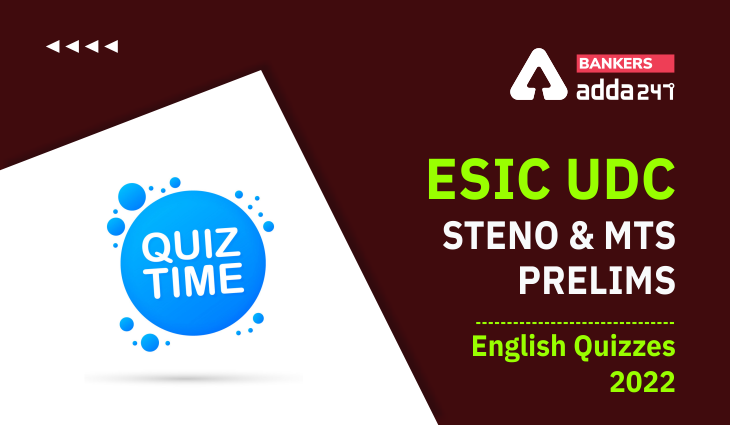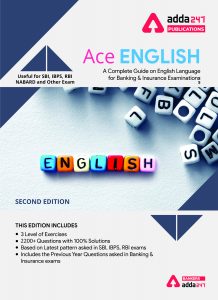Directions (1–5) Read the following passage carefully and answer the questions given below it. Certain words/phrases have been printed in bold to help you locate them while answering some of the questions.
Those examples of poetic justice that occur in medieval and Elizabethan literature, and that seem so satisfying, have encouraged a whole school of twentieth-century scholars to “find” further examples. In fact, these scholars have merely forced victimized character into a moral framework by which the injustices inflicted on them are, somehow or other, justified. Such scholars deny that the sufferers in a tragedy are innocent; they blame the victims themselves for their tragic fates. Any misdoing is enough to subject a character to critical whips. Thus, there are long essays about the misdemeanors of Webster’s Duchess of Malfi, who defined her brothers, and the behavior of Shakespeare’s Desdemona, who disobeyed her father.
Yet it should be remembered that the Renaissance writer Matteo Bandello strongly protests the injustice of the severe penalties issued to women for acts of disobedience that men could, and did, commit with virtual impunity. And Shakespeare, Chaucer, and Webster often enlist their readers on the side of their tragic heroines by describing injustices so cruel that readers cannot but join in protest. By portraying Griselda, in the Clerk’s Tale, as a meek, gentle victim who does not criticize, much less rebel against the prosecutor, her husband Walter, Chaucer incites readers to espouse Griselda’s cause against Walter’s oppression. Thus, efforts to supply historical and theological rationalization for Walter’s persecutions tend to turn Chaucer’s fable upside down, to deny its most obvious effect on reader’s sympathies.
Similarly, to assert that Webster’s Duchess deserved torture and death because she chose to marry the man she loved and to bear their children is, in effect to join forces with her tyrannical brothers, and so to confound the operation of poetic justice, of which readers should approve, with precisely those examples of social injustice that Webster does everything in his power to make readers condemn. Indeed. Webster has his heroin so heroically lead the resistance to tyranny that she may well inspire members of the audience to imaginatively join forces with her against the cruelty and hypocritical morality of her brothers. Thus Chaucer and Webster, in their different ways, attack injustice, argue on behalf of the victims, and prosecute the persecutors. Their readers serve them as a court of appeal that remains free to rule, as the evidence requires, and as common humanity requires, in favour of the innocent and injured parties. For, to paraphrase the noted eighteenth-century scholar, Samuel Johnson, despite all the refinements of subtlety and the dogmatism of learning, it is by the common sense and compassion of readers who are uncorrupted by the characters and situations in medieval and Elizabethan literature, as in any other literature, can best be judged.
Q1.According to the passage, some twentieth-century scholars have written at length about
(a)Walter’s persecution of his wife in Chaucer’s the Clerk’s Tale
(b)the Duchess of Malfi’s love for her husband
(c)the tyrannical behaviour of the Duchess of Malfi’s brothers
(d)the actions taken by Shakespeare’s Desdemona
(e)the injustices suffered by Chaucer’s Griselda
Q2.The primary purpose of the passage is to
(a)describe the role of the tragic heroine in medieval and Elizabethan literature
(b)resolve a controversy over the meaning of “poetic justice” as it is discussed in certain medieval and Elizabethan literary treatises
(c)present evidence to support the view that characters in medieval and Elizabethan tragedies are to blame for their fates
(d)assert that it is impossible for twentieth-century readers to fully comprehend the characters and situations in medieval and Elizabethan literary works
(e)argue that some twentieth-century scholars have misapplied the concept of “poetic justice” in analyzing certain medieval and Elizabethan literary works.
Q3.It can be inferred from the passage that the author consider Chaucer’s Grisselda to be
(a)an innocent victim
(b)a sympathetic judge
(c)an imprudent person
(d)a strong individual
(e)a rebellious daughters
Q4.The author’s tone in her discussion of the conclusions reached by the “school of twentieth-century scholars” (written in line 4) is best described as
(a)plaintive
(b)philosophical
(c)disparaging
(d)apologetic
(e)enthusiastic
Q5.It can be inferred from the passage that the author believes that most people respond to intended instances of poetic justice in medieval and Elizabethan literature with
(a)annoyance
(b)disapproval
(c)indifference
(d)amusement
(e)gratification
Directions (6-10): Rearrange the following six sentences (A), (B), (C), (D), (E), and (F) in the proper sequence to form a meaningful paragraph and then answer the questions given below.
A. Depression is possible and if they don’t get enough exercise, obesity is also on the cards.
B. A lot of people keep dogs tied all day.
C. They could exhibit other behavioural disorders such as chewing on their own leg or licking themselves constantly out of boredom, causing skin problems.
D. The other major risk is exposure to the elements for example, when they are tied in direct sunlight; they are at risk of dehydration and heat stroke.
E. Habitual tying is never a good thing.
F. This causes behavioural issues – they might start to become excessively vociferous or aggressive.
Q6. Which of the following would be the FOURTH sentence after rearrangement ?
(a) E
(b) D
(c) C
(d) A
(e) F
Q7. Which of the following would be the FIRST sentence after rearrangement ?
(a) C
(b) A
(c) D
(d) B
(e) E
Q8. Which of the following would be the THIRD sentence after rearrangement ?
(a) F
(b) C
(c) E
(d) B
(e) D
Q9. Which of the following would be the FIFTH sentence after rearrangement ?
(a) C
(b) A
(c) B
(d) D
(e) F
Q10. Which of the following would be the SECOND sentence after rearrangement ?
(a) D
(b) E
(c) F
(d) B
(e) C
Directions (11-15): In the following questions, a sentence has been given with some of its parts in bold. To make the sentence grammatically correct, you have to replace the bold part with the correct alternative given below. If the sentence is correct as it is, give (e) as your answer (i.e. No correction required).
Q11. Even less intelligent students can be succeeded through hard work and perseverance.
(a) get succession
(b) be successfully
(c) get success
(d) be getting succeeded
(e) No correction required
Q12. Rahul as well as his friends talk more then others.
(a) talk more than
(b) has been talking much more than
(c) talks more than
(d) have talked
(e) No correction required
Q13. Being a man of principle, he refused to follow the illegitimate instructions.
(a) following the illegitimate
(b) to following the illegitimately
(c) to follow the illegitimately
(d) Not to follow the illegitimately
(e) No correction required
Q14. The active learning of adulthood is not only possible but infinitely and desirable.
(a) only possible but also infinitely
(b) only possible but also infinite and
(c) possible only if infinite and
(d) only possible but infinitely
(e) No correction required
Q15. The teacher asked the intruder who was he and why was he occupying his chair.
(a) who he was and why he was
(b) who he was and why was he
(c) who he had been and why he had been
(d) who is he and why he is
(e) No improvement
Solutions
S1. Ans.(d)
Sol. The answer lies in the last line of the first paragraph “Thus, there are long essays about the misdemeanors of Webster’s Duchess of Malfi, who defined her brothers, and the behavior of Shakespeare’s Desdemona, who disobeyed her father.”
S2. Ans.(e)
Sol. In the passage the author argue that some twentieth-century scholars have misapplied the concept of “poetic justice” in analyzing certain medieval and Elizabethan literary works.
S3. Ans.(a)
Sol. Refer to the third sentence of the second paragraph “By portraying Griselda, in the Clerk’s Tale, as a meek, gentle victim who does not criticize, much less rebel against the prosecutor, her husband Walter, Chaucer incites readers to espouse Griselda’s cause against Walter’s oppression.” Hence option (a)is correct.
S4. Ans.(c)
Sol. The author is critical about the conclusions reached by the “school of twentieth-century scholars” .Therefore option (c) is true.
S5. Ans.(e)
Sol. The answer can be concluded from the second last sentence of the last paragraph “Their readers serve them as a court of appeal that remains free to rule, as the evidence requires, and as common humanity requires, in favour of the innocent and injured parties.” So the reader respond the literature with gratification.
For questions (6- 10): The proper sequence of sentences to form a meaningful paragraph will be EBFCAD
S6. Ans.(c)
S7. Ans.(e)
S8. Ans.(a)
S9. Ans.(b)
S10. Ans.(d)
S11. Ans.(c)
Sol. Possibility which is strong and gives the sense of ability must be conveyed by the use of ‘can’. So, (c) is appropriate.
S12. Ans.(c)
Sol. In sentences with structure ‘sub’ + as well as + ‘sub’, the verb which follows depends on the number of subject which is used before ‘as well as’. Since, Rahul is singular, verb used should also be singular hence either (b) or (c) is the correct option. But, since, the question doesn’t show a point or period of time, we are left with (c) which is the correct option.
S13. Ans.(e)
Sol. No correction required
S14. Ans.(a)
Sol. ‘not only’ is used with ‘but also’ so either (a) or (b) is the correct option. Now this sentence has the structure ‘adverb (infinitely) + adjective (desirable)’ so the usage of ‘and’ is superfluous. Hence, (a) is the correct option.
S15. Ans.(a)





 English Language Quiz For Bank Foundatio...
English Language Quiz For Bank Foundatio...
 English Language Quiz For SBI Clerk Prel...
English Language Quiz For SBI Clerk Prel...
 English Language Quiz For SBI Clerk Prel...
English Language Quiz For SBI Clerk Prel...


